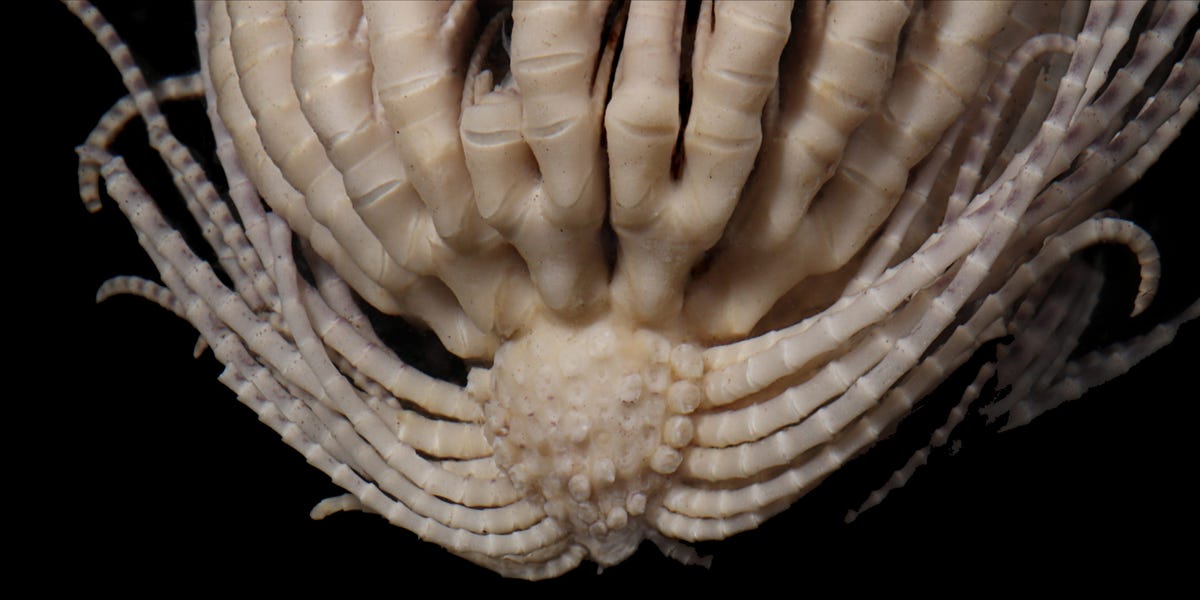- Scientists discovered a new species of feather stars with 20 “arms”.
- The species is part of the Antarctic feather star group and is largely related to starfish.
- Scientists named their discovery after a strawberry.
Scientists trawling the sea near Antarctica uncovered a new species that looks awful in pictures – but named it after a fruit.
The Antarctic strawberry starfish is a sea creature with 20 so-called “arms” — some bumpy, some springy — and can be up to eight inches long in total, Greg Rouse, a professor of marine biology at the University of California, San Diego, told Insider.
Rouse wrote the paper on the new species with researchers Emily McLaughlin and Nerid Wilson, and published their findings in Invertebrate systematics last month.
The alien-like creature doesn’t seem like a strawberry at first. But if you zoom in on its body — a little nub at the tip of all those arms — it resembles the size and shape of the fruit.
The circular bumps on the star’s body are where the cirri — the smaller tentacle-like strands that protrude from the base — should be, but were removed to show the attachment points, Rouse said.
“We’ve removed a bunch of cirri so you can see the parts that they’re attached to, and that’s what looks like a strawberry,” he said.
He added that cirri have small claws at the end that are used to cling to the bottom of the seabed.
The so-called arms are the longer, feather-like parts of the Antarctic strawberry plume star shown in the photo. They’re usually spread out, Rouse said, and help with the creature’s mobility.
The formal name of the new species is Promachocrinus fragarius. It belongs to the class Crinoidea, which includes starfish, sea urchins, sand dollars and sea cucumbers, and is a type of feather star – hence the less formal name “Antarctic feather star”. Fragarius comes from the Latin word “fragum,” meaning strawberry, according to the paper.
The professor said in an interview that originally there was only one species under the Antarctic feather star group – Promachocrinus kerguelensis.
But by casting a net along the Southern Ocean looking for more specimens of these creatures, the team of researchers from Australia and the United States identified four new species that may fall under the Antarctic feather star group.
The Antarctic Strawberry Feather Star stands out in particular because of the number of “arms” it has. “A majority of comets have 10 arms,” Rouse said.
Rouse added that the typical position of a feather star is to have the “arms” spread and upward, while the cirri point downward.
With this discovery, scientists were able to add eight species under the Antarctic feather star category, adding the four new discoveries and “reviving” previously discovered animals that were originally thought to be their own species, Rouse said.
“So we went from one species with 20 arms to now eight species — six with 20 arms and two with 10 arms under the name Promachocrinus,” Rouse said.
According to the paper, the Antarctic strawberry plume was found somewhere between 215 feet to about 3,840 feet below the surface.
Researchers acknowledged in their paper the “extraterrestrial appearance of the swimming movements of the feather stars.”
But finding new species in general is not a rare phenomenon, Rouse said, adding that his lab at the university’s Scripps Institution of Oceanography names up to 10 to 15 species a year.
“We’re finding a lot of species. The problem is the amount of work that goes into actually naming them,” he said.
NOW WATCH: Top Videos from Insider Inc.
Loading…
#Scientists #Discover #Species #Comets #Arms
